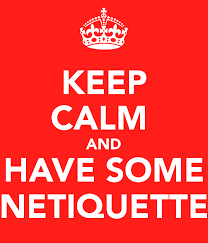Netiquette: How to be "proper" on the internet
- J. Peters
- Jul 15, 2018
- 3 min read

Netiquette seems to be exactly what it sounds like, proper etiquette on the internet, but I wonder how it might differ from digital citizenship. In my own reflection of the terms, I imagine Digital Citizenship to be more broad in its approach, while Netiquette might refer to more specific guidelines created to encourage appropriate use of technology. The question is, who creates these guidelines and how do we ensure that they are followed, particularly in an educational setting? Is it important for students to learn Netiquette specifically and how do we best teach it? The school that I work in doesn't seem to have a specific policy on Netiquette so I thought I might consider how to begin to address these important student responsibilities in my own classroom.
The Victoria Australia State Department describes Netiquette as the following:
“Netiquette is about relationships and how people behave, rather than about particular websites or pieces of technology”.
Considering our own personal bottom lines surrounding use of technology, and how they might differ in a classroom of thirty high school students, I thought about how creating and implementing a Code of Netiquette in my own classroom could be done. As I mentioned in my blog post last week, much of my interaction surrounding student use of technology in class seems to be about negotiating time on or off the cell phone. Rather than imposing my beliefs surrounding netiquette, I think that empowering students to come up with their own Code and then sharing that as a class, posting it and sharing it with parents would be valuable. The Digital Youth Summit 2015 Report for Day One: Cyber citizenship, heard the views of secondary students from across Canada and in the document students state that they were "unenthusiastic at the prospect of learning digital skills from "anyone much older." Teachers (specifically those that "don't know tech"), seniors and parents were included in this category." (p.12) Giving students the opportunity to voice what they know and work as a community to develop their own shared beliefs surrounding netiquette will engage students more than a lecture from that older adult.
I thought I might develop a series of questions for students to consider in creating their Code of Netiquette.
When we think of “proper etiquette”, we might think of being polite. How can we be polite in our communication online? Is polite a word that needs to be considered?
We have ideas surrounding safety when we are out in the community. How can we keep ourselves safe in the online community? What does respecting privacy look like?
We can likely identify what would be considered appropriate behaviour in school. Does this change when we are online? Does the way in which we communicate change when we are on social media?
How can we respect ourselves, others and the social media forum that we are a part of?
The questions listed above might not be the right questions to ask. My understanding of Netiquette based on what I know and where I visit online may be very different from students who are using diverse social media platforms. I think being open to discussions and ideas flowing and keeping the Code fluid so that the conversation is ongoing throughout the academic year would be integral to student engagement.
Below are a list of resources that I would like to incorporate as part of our ongoing discussions. The wealth of knowledge on the subject that already exists means that teachers can look to resources from around the world.
Resources worth checking out:
https://mediasmarts.ca/digital-media-literacy/e-tutorials/respecting-yourself-others-online-workshop
References
The Digital Youth Summit 2015 Report for Day One: Cyber citizenship (2015). Retrieved from https://mediasmarts.ca/sites/mediasmarts/files/publication-report/full/youth-summit-may-2015.pdf
Victoria State Education and Training Advice Sheets: Netiquette (2013). Retrieved from https://www.education.vic.gov.au/Documents/about/programs/bullystoppers/afnetiquette.pdf
Keep Calm Source: http://sd.keepcalm-o-matic.co.uk






Comments